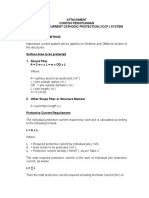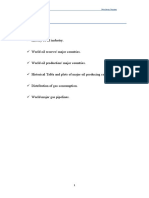METHODOLGY
METHODOLGY
Uploaded by
المبروك مراجع المبروكCopyright:
Available Formats
METHODOLGY
METHODOLGY
Uploaded by
المبروك مراجع المبروكCopyright
Available Formats
Share this document
Did you find this document useful?
Is this content inappropriate?
Copyright:
Available Formats
METHODOLGY
METHODOLGY
Uploaded by
المبروك مراجع المبروكCopyright:
Available Formats
CHAPTER THREE
METHODOLGY
1.1. Introduction
In this chapter is dealing with the experimental work carried out in this study.
Arabin Gulf Oil Company (AGOCO) is located in the city of Tobruk in Libya, the
company's branch, and the system in place to protect the transfer of oil pipeline diameter of
34ʺ and the length of 513 km. The Arabian Gulf Oil Company is a Libyan oil company
headquartered in Benghazi, Libya. It works in the search and exploration for crude oil and
natural gas, its production and refining. It was established in 1971 and is affiliated with the
National Oil Corporation. It has a number of branches, including a branch in Tobruk,
where the Tobruk refinery and the Harika port of Tobruk are located. The buried pipeline
(Sarir pipeline) by an impressed current cathodic protection system. This system of
impressed current cathodic protection has been added to the passive protection system
provided by the pipe insulating coating (wrapping )
1.2. The pipeline characteristics:
The pipeline specific characteristics are as follows:
1. Pipeline diameter: 34ʺ.
2. Pipeline length: 513 km.
3. Pipeline length protected: 44 km.
4. Design pressure: 40 bar.
5. Normal operating pressure: 32.7 bar.
6. Material properties: Carbon steel XL45.
7. Wall thickness: 9.5 mm.
8. Burial depth: 0.75 : 1.5 m.
9. Minimum normal temp: -10 C° (blow down).
10. Maximum normal temp: 24 C° (at pump outlet).
1.3. Cathodic protection system:
The pipeline is catholically protected by an impressed current system. The pipe-to
soil potential is also monitored by the test posts are located at a nominal 4 km spacing
along the pipeline route. The impressed current system was designed to cope with a 75%
reduction in coating performance from an initial 20,000 ohm/m² to 5,000 ohm/m². In
addition, there is a 100% over capacity in the cathodic protection station sizing.
The following criterion was set for the operation of the system. "Off" pipe to soil
potentials or "Off" coupon potentials should be maintained more negative than -0.85V with
respect to a Cu/ CuSO4 reference electrode. "On" pipe to- soil potentials should not be
more negative than -1.5 to reduce the risk of cathodic disbandment of the coating. The
design for the C.P. system is based on coating deterioration (after 15/20 years).
Calculations are based on following formulas (Butter worth-Heinemann 1993)
σ
RL= =Ohms / Km
π DT H
R
RI = =Ohms / Km
n D 1000
Rc=√ RL . RI =Ohms
α=
√ RL
RI
=1/ Km
αL=σ . L
Rc
ℜ= =Ohms
t g h αL
VM =Vm cosh α =volts
I =VM /ℜ= Amps
Where:
R = Insulation resistance
Th = Pipe thickness.
D = Pipe diameter.
L = Pipe length to be protected
RL = Longitudinal resistance
RI = Transversal resistance
Rc = Characteristic resistance
σ = 1/km Characteristic index
Re = Equivalent resistance
VM = Voltage between pipe and soil at each end
Vm = Voltage between pipe and soil at midpoint
I = protective current at each end of the pipe
1.4. Calculating of the Cathodic protection station
Calculating the CP station (at station 500 km) using 5,000 ohms.m² the maximum
protected distance is 44 km (overall 513 km) and the relevant maximum current required is
100 Amps.
In fact:-
1.4.1. Calculation the Longitudinal resistance
From the given data and using the equation
σ
RL= =Ohms / Km
π DT H
the Longitudinal resistance is RL = 5.9880 ohms km-1
1.4.2. Calculation the Transversal resistance
From the given data and using the equation
R
RI = =Ohms / Km
n D 1000
The Transversal resistance is RI = 0.2316 ohms . km−1.
1.4.3. Calculation the Characteristic resistance
From the given data and using the equation
R
RI = =Ohms / Km
n D 1000
The Characteristic resistance is Rc = 1.177 ohms.
.
Figure 3.1: Measurement of ON Potential
1.5. Coating
The pipe is coated with wrapping . The coating was applied generally in accordance
with Shell Expro Standard ES/014. The coating was applied by electrostatic spraying ,
white metal, blast cleaned surface. The surface of the pipe was pre-treated with a
chromatic conversion coating to improve its resistance to cathodic disbonding. The dry
film thickness was 350 ± 50 microns.
1.6. Transformer Rectifiers
The transformer data
Cable route marker, 1700mm long
Angle iron 50x50x5mm galvanized with 2 plates
Transformer rectifier unit 60V/100A, oil cooled
Transformer rectifier unit, oil cooled, with sunshade
AC input : 415V, 3phase, 50Hz
DC output: 60V/100A
Output control : continuous 0 – 100A by auto transformer
Hazardous area: None
With top control cabinet,
Oil tank, oil level, Thermometer, Silicagel Breather c/w over voltage protection
Devices on AC and DC circuits, DC voltmeter 0-60V, DC Ammeter 0-100A
Figure 3.2 : Transformer rectifier at Tobruk station
1.7. Anode junction box (AJB)
The Anode junction box consist of
1. Cast aluminum alloy box with dimensions 404 mm x 313 mm x 180 mm,
complete with mounting plate,5 nos. shunts 50mV/10A,
2. Copper rail
3. Steel support( 440 x 1250mm)
4. Galvanized steel conduct type M50
1.8. Magnetite Anodes chain type 25-5-5/105V
Magnetite anode string assembly with 25 nos. anodes, consisting 5chains with 5
nos magnetite anodes each. space between anodes 1.68m. Free length of 10mm 2 PVDF
cable above top anode 105m , all plastic components of chain made from PVDF material ,
each chain provided with titanium suspension ring for fixing at supporting axle inside
wellhead structure. This special type of magnetite anode chains are used for deep well
anode ground beds, both open hole and close hole. As open hole anode ground bed they
can be used in conjunction with non-conductive slotted casing without backfill but can also
be used in close hole ground beds with coke backfill material in case of unstable or non-
existing static water level.
All parts of anodes, anode chains and suspension devices are made of material
resistant against low pH value, high chloride content of water and high concentration of
chlorine gas. Each anode is center connected to the cable using copper compression clamp
and a bronze connection spring. The internal space is filled with a two component mixture
of polyurethane and polyester. Each anode chain has one individual lead cable connection
ready for fixing on suspension device inside ground bed head structure.
1.8.1. Anode Specification
Table 3.1 : Anode Specification
Diameter 60mm
Total length 740mm
Effective length 600mm
Total weight 6.2 kg
Min. effective mass 4.7 kg
Surface area 11.3dm2
Max. current load ( grounded) 4A
1.8.2. Anode consumption and anode connection
1. The calculated consumption rate was 0.2 Kg/Ampere-year
2. Free length of 10mm2 above PVDF cable above top anode 105m all plastic
components
3. Magnetite anode string assembly with 25nos consisting of 5 chains made from
PVDF.
1.9. Test points
The (3 inch) pipe which moves the ground base, containing copper cable to take readings of
voltage. Figure 2.3 shows one of test-point that used in CP system
Figure 3.3 : Test point
1.10. Soil resistivity measurements
Soil resistivity measured by soil resistance, BBC GOERZ METAWATT Fig.(2.4). The 4
pins should be driven into the ground in the straight line at 50 cm spacing. Good contact
with the soil is important. The two "C" binding posts are connected to the end pins, and the
two "P" binding posts are connected to the adjust center pins.
Figure 3.4 : Soil resistivity meter
1.11. Copper / Copper sulfate electrode
The figure 3.5: shows Cu / CuSO4 electrode consists of a piece of copper, a saturated
solution of copper sulfate in contact with a copper; a porous member placed in contact with
a soil. Excess crystals are added, to ensure that the solution always will be saturated.
Figure 3.5 : Copper / Copper sulfate electrode
You might also like
- Oil & Gas Industry in Libya 1Document28 pagesOil & Gas Industry in Libya 1Suleiman Baruni100% (1)
- ICCPDocument7 pagesICCPAris MunandarNo ratings yet
- Basic Electrical Ideas and Units PDFDocument56 pagesBasic Electrical Ideas and Units PDFFlorenzo Miguel Aclan100% (1)
- Libya 2012 LEER PDFDocument10 pagesLibya 2012 LEER PDFJose Martinez100% (1)
- Electricity Fundamental EquationsDocument5 pagesElectricity Fundamental EquationsKristian ForestNo ratings yet
- Ee2325 - P1 - L2 - Resistance of TLDocument21 pagesEe2325 - P1 - L2 - Resistance of TLHendrick Brian QuezaNo ratings yet
- Physics ProjectDocument16 pagesPhysics ProjectShivam JindalNo ratings yet
- EEE 305 A Fall2024 HB Lecture#2Document21 pagesEEE 305 A Fall2024 HB Lecture#2rj OpuNo ratings yet
- Teaching Notes On Track CircuitsDocument12 pagesTeaching Notes On Track CircuitsRamij MujawarNo ratings yet
- BEE3133 Electrical Power Systems: Transmission Line ParametersDocument84 pagesBEE3133 Electrical Power Systems: Transmission Line ParametersLittle CandyNo ratings yet
- The CurrentDocument5 pagesThe CurrentJoan BalendrezNo ratings yet
- Covergence of DC Resistance To Ac ResistanceDocument37 pagesCovergence of DC Resistance To Ac ResistanceBiswajit Naik100% (1)
- Telecommunication Lab ManualDocument34 pagesTelecommunication Lab ManualPrashant Kulshreshtha100% (1)
- Cables and WireDocument12 pagesCables and WireBurraq Engineering SolutionsNo ratings yet
- Chap 11. CURRENT AND RESISTANCEDocument15 pagesChap 11. CURRENT AND RESISTANCEmarkeepetesentuineNo ratings yet
- Lecture 1 ResistorsDocument26 pagesLecture 1 ResistorsMayank AgarwalNo ratings yet
- Common Data and Formulas CableDocument5 pagesCommon Data and Formulas CableH. NurzeinNo ratings yet
- Technical Specification For 3C XPLE CableDocument9 pagesTechnical Specification For 3C XPLE Cableramana3339No ratings yet
- 965DSP OSP Basics PDFDocument88 pages965DSP OSP Basics PDFRamyAyashNo ratings yet
- CED107 - RF and Microwave Circuit Design - QuestionsDocument2 pagesCED107 - RF and Microwave Circuit Design - Questionsatanu.ece.citulubNo ratings yet
- Week 5-7 Inductance of TLsDocument59 pagesWeek 5-7 Inductance of TLsSyed Faras HaiderNo ratings yet
- Wa0000.Document28 pagesWa0000.Ayushi BishtNo ratings yet
- Características Básicas de CablesDocument38 pagesCaracterísticas Básicas de CablesJesica Tèvez GauvainNo ratings yet
- Transmission LinesDocument77 pagesTransmission LinesMaraMendozaNo ratings yet
- Chapter 2 Transmission Lines New1Document52 pagesChapter 2 Transmission Lines New1abdul hadi ps100% (1)
- TLW # MarksDocument10 pagesTLW # MarksRamanan SvNo ratings yet
- 30-300 MHZ Transmission Line Trainer Tla05Document1 page30-300 MHZ Transmission Line Trainer Tla05Kishor HandoreNo ratings yet
- Power and Control CablesDocument27 pagesPower and Control CablesAbhishek KumarNo ratings yet
- Transmission Line Parameters NewDocument80 pagesTransmission Line Parameters NewteddydemerewNo ratings yet
- AttenuationDocument8 pagesAttenuationm_michael_cNo ratings yet
- Chapter 3 (Parameters of TX Lines)Document83 pagesChapter 3 (Parameters of TX Lines)Nati Man Dejene100% (1)
- Industrial Training Institute AmreliDocument104 pagesIndustrial Training Institute Amrelimrsumitchandak100% (1)
- LV DESGIN FOR TRAINING Manual FinalDocument8 pagesLV DESGIN FOR TRAINING Manual FinalBehailu Mulugeta100% (1)
- I RobotricksDocument22 pagesI RobotricksShivanshscribdNo ratings yet
- MethodDocument2 pagesMethoda.singhNo ratings yet
- Measurement of Insulation Resistance IR Part 2Document12 pagesMeasurement of Insulation Resistance IR Part 24843079No ratings yet
- Welcome To Totaline University: Electrical FundamentalsDocument95 pagesWelcome To Totaline University: Electrical FundamentalsabuMalak75% (4)
- 965dsp Osp BasicsDocument88 pages965dsp Osp BasicsH Aries Drk MunansNo ratings yet
- 4 24573 360 PDFDocument3 pages4 24573 360 PDFrhap_0925060No ratings yet
- EE 517 Power System Analysis and Design Lecture 1 Transmission Line ParametersDocument22 pagesEE 517 Power System Analysis and Design Lecture 1 Transmission Line ParametersAlexis AguillonNo ratings yet
- Insulation Resistance (IR) ValuesDocument14 pagesInsulation Resistance (IR) ValuesHimdad Tahir100% (5)
- ELECTROMAGNETISMDocument31 pagesELECTROMAGNETISMdeonatussospeter73No ratings yet
- Sample EMD TestDocument1 pageSample EMD TestndthokareNo ratings yet
- Track Circuit FOR RAILWAYDocument28 pagesTrack Circuit FOR RAILWAYVikas Srivastav84% (31)
- PCB Details SPC MksDocument61 pagesPCB Details SPC MksDharma LingamNo ratings yet
- 04 Transmission LinesDocument6 pages04 Transmission Lineskartheek32777No ratings yet
- Phys 1 TV LectDocument3 pagesPhys 1 TV LectEerah Jane EspinarNo ratings yet
- Chapter 4 SlidesDocument36 pagesChapter 4 Slidesmekonen100% (2)
- Final Exam Imp QuestionDocument20 pagesFinal Exam Imp Questionshaikhnuman440No ratings yet
- Elecrolysis Cell DrawingDocument2 pagesElecrolysis Cell DrawingRimaNo ratings yet
- Protective Relay Type CPR For Rubber Bag ConservatorDocument5 pagesProtective Relay Type CPR For Rubber Bag ConservatorAshraf NazifNo ratings yet
- PHY 102 Part B, Lecture 2Document6 pagesPHY 102 Part B, Lecture 2amisuislameeyahNo ratings yet
- Neutral GroundingDocument1 pageNeutral GroundingVenu GopalNo ratings yet
- Powerpoints Electric CircuitsDocument9 pagesPowerpoints Electric CircuitsmvmbappleNo ratings yet
- Salinity Alarm Equipment For Ship BoilerDocument7 pagesSalinity Alarm Equipment For Ship BoilerMaritime MineNo ratings yet
- Transmision of Electric PowerDocument110 pagesTransmision of Electric PowerQadeer ZahidNo ratings yet
- Basic ElectronicsDocument30 pagesBasic Electronicsfmulamba498No ratings yet
- Numerical ProblemsDocument4 pagesNumerical Problemsvivek soniNo ratings yet
- GC1 TCN2000270 Pe Ma 2Document19 pagesGC1 TCN2000270 Pe Ma 2teodoralexiuimpacNo ratings yet
- World Oil ProductionDocument25 pagesWorld Oil ProductionSuleiman BaruniNo ratings yet
- 2011 Horizontal Underbalanced Drilling Technology Successfully Applied in Field AA - Libya PDFDocument11 pages2011 Horizontal Underbalanced Drilling Technology Successfully Applied in Field AA - Libya PDFcarlorgs100% (1)
- Libyan Oil ReservesDocument12 pagesLibyan Oil Reservesmohammad_abubaker100% (1)
- Human Factor EngineeringDocument17 pagesHuman Factor EngineeringHamed MasaodNo ratings yet
- A Simulation Study of The Sarir Field - Tobruk Terminal Crude Oil PipelineDocument6 pagesA Simulation Study of The Sarir Field - Tobruk Terminal Crude Oil PipelineteaNo ratings yet
- Geomechanics Pinpoint Cause of Sand ProductionDocument2 pagesGeomechanics Pinpoint Cause of Sand ProductionazareiforoushNo ratings yet
- Oil and Gas in A New Libyan EraDocument25 pagesOil and Gas in A New Libyan EraAbdulslam100% (1)
- US EIA March 2022 Libya Country Analysis Executive SummaryDocument11 pagesUS EIA March 2022 Libya Country Analysis Executive SummarySalah ElbakkoushNo ratings yet
- Market Study Questions (V01)Document21 pagesMarket Study Questions (V01)Malek r.i.pNo ratings yet
- Netherlands Embassy LetterDocument11 pagesNetherlands Embassy LetterYOUSAF ALINo ratings yet
- Oil & Gas Industry in Libya 2Document36 pagesOil & Gas Industry in Libya 2Suleiman BaruniNo ratings yet
- Libia EiaDocument12 pagesLibia EiaFreedom BreezeNo ratings yet










































































